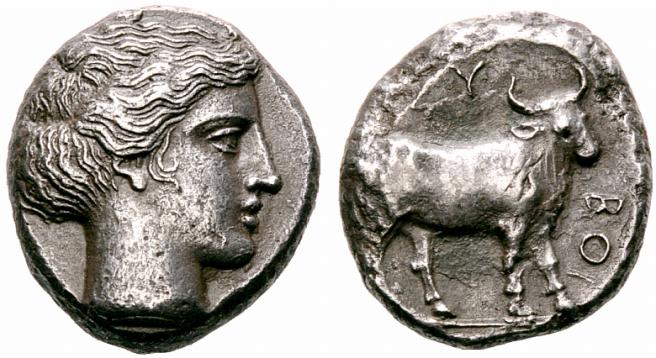Eretria, silver, tetradrachms (400-395 BCE)
From SILVER
400 BCE - 395 BCE Silver 1,696 kg
Description
| ObverseInscription or printing placed on the obverse.: | Head of nymph Euboia to right, hair rolled, wearing no earring or necklace. |
| ReverseInscription or printing placed on the reverse.: | EYB (Greek).Cow standing to right on exergue line, head turned three-quarter right, EYB above |
Mint and issuing power
| MintIdentifies the place of manufacture or issue of a numismatic object.: | Eretria | Ancient regionAncient region.: | Euboea | Modern countryModern country: Greece | AuthorityIdentifies the issuing power. The authority can be "pretended" when the name or the portrait of X is on the coin but he/she was not the issuing power. It can also be "uncertain" when there is no mention of X on the coin but he/she was the issuing power according to the historical sources: | Euboean League |
Chronology
| FromIdentifies the initial date in a range assigned in a numismatic context. | 400 BCE | toIdentifies the final date in a range assigned in a numismatic context.. | 395 BCE | PeriodTime period of the numismatic object.: Classical 480-323 BC |
Physical description
| MetalThe physical material (usually metal) from which an object is made.: | Silver |
Median weightMedian of the weights of numismatic objects (in grams). in grams | 16.40 | DenominationTerm indicating the value of a numismatic object. Examples: tetradrachm, chalkous, denarius.: | tetradrachm |
StandardStandard.: |
Image

AC187 Eretria.jpeg [1]
References
| Die study referencePublication of the study: | Wallace 19561Wallace 1956, n° 14-8. | ||
| Coin series referenceReference to coin series study: | Sear I2Sear I, n° 2463, RQEMAC3RQEMAC, n° 187, HGC 44HGC 4, n° 1413 | ||
Obverse dies distribution
| FrequencyFrequency of specimen in distribution. ᵖ | Number of obversesNumber of obverse dies. ᵖ (o) | % (o) | Number of coinsNumber of coins. (n) | % (n) | Die nameName(s) of the die(s). |
| 3 | 1 | 20 | 3 | 7.32 | 10 |
| 6 | 1 | 20 | 6 | 14.63 | 9 |
| 8 | 1 | 20 | 8 | 19.51 | 7 |
| 11 | 1 | 20 | 11 | 26.83 | 8 |
| 13 | 1 | 20 | 13 | 31.71 | 6 |
| Total | 5 of 5 | 100 | 41 of 41 | 100 |
Reverse dies distribution
no distribution is available
Quantification
| Number of obversesNumber of obverse dies. ᵖ (o) | 5 | Number of singletons (o1)The number of singleton coins. ᵖ | |
| Number of reverse diesNumber of reverse dies. (r) | 2 | Number of coinsNumber of coins. (n) | 41 |
| Coins per obverse dieNumber of coins per obverse die. (n/o) | 8.2 | Coins per reverse dieNumber of coins per reverse die. (n/r) | 20.5 |
| Reverse per obverse ratioRatio of obverse dies divided by reverse dies. (r/o) | 0.4 | Percentage of singletons (o1)number of coins (n) divided by the number of singletons (o1) ᵖ | % |
| Original number of dies (O) (Carter 1983 formula)The estimation of the number of coins according to Carter 1983 ᵖ | 5.17 | Coins struck if 20,000 as average productivity per dieCoins made if the average productivity for obverses (according to Carter) is 20,000. ᵖ | 103,400 |
| Original number of dies (O) (Esty 2011 formula)The estimation of the number of coins according to the singleton formula in Esty 2011 ᵖ (O) | 5.69 | Survival rate if 20,000 as average productivity per dieSurvival rate if average productivity is 20,000. ᵖ | 0.00040 |
| Coverage (o = % of O) (Esty 1984 formula)Esty 1984 - coverage (% of O) ᵖ (o = % of O) | % | Die productivity if survival rate 1/2,000Average productivity if survival rate is 1/2,000. ᵖ | 15,860.74 |
| Weight of silver (in kg) if 20,000 coins per die (O = Carter formula)Carter 1983 * Median weight * 20000 (*10 if gold or electrum) ᵖ | 1,696 kg <br /> 1,696 kg | Die productivity if survival rate 1/5,000Average productivity if survival rate is 1/5,000. ᵖ | 39,651.84 |
Remarks
Most likely one single workstation